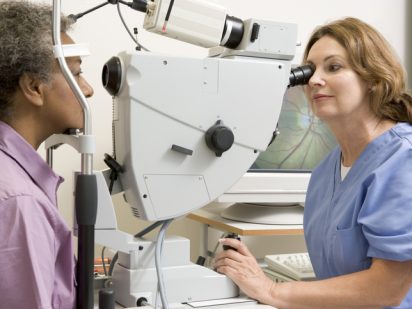When it comes to glaucoma, prevention is key.
Glaucoma is a group of eye conditions that damage the optic nerve, an imperative part of good vision. It is estimated that over three million Americans have glaucoma, but only half of them know they have it. According to the American Academy of Ophthalmology, glaucoma happens when fluid builds up in the front part of the eye and damaging the optic nerve in the process.
Glaucoma is not curable and any vision that is lost cannot be brought back, said Darrell Williams, MD, an ophthalmologist with Trinity Health, noting that the total focus on glaucoma is prevention.
The most common form of glaucoma, which is 90 percent of all glaucoma cases, is called chronic open angle glaucoma. “It’s silent. You don’t know you have it,” he said. “It can damage the eye before the patient realizes it.”
It occurs when the eye does not drain fluid as well as it should, like it was a clogged drain. The eye pressure builds and starts to damage the optic nerve.
The first thing a person with chronic open angle glaucoma experiences is a loss of side vision and nighttime vision. “You can lose most of the optic nerve before you realize it. It’s kind of like somebody with high blood pressure who doesn’t realize they have it until they have a heart attack or stroke,” Dr. Williams said. “You won’t know you have it unless you check it now and then. That’s why a pressure check with an eye exam is so important.”
Open angle glaucoma can be checked anytime during a routine exam with an optometrist or ophthalmologist, Dr. Williams said.
A rare form of glaucoma is angle-closure glaucoma, which happens when the iris is very close to the drainage angle. It can end up blocking the drainage angle.
Unlike chronic open angle glaucoma, there are signs to look out for. They include:
- Vision is suddenly blurry
- Severe eye pain
- Headache
- Nausea/vomiting
- Rainbow-colored rings or halos around lights
If you show signs of glaucoma, especially if you are at risk, it is imperative to see your family eye doctor. An ophthalmologist or optometrist will review your medical history and conduct a comprehensive eye examination that could include several tests, including: measuring intraocular pressure, or tonometry; testing for optic nerve damage with a dilated eye examination and imaging tests; checking for areas of vision loss, or visual field test, or inspecting the drainage angle, or gonioscopy.
If you are under the age of 60, having an exam to check for open-angle glaucoma every two years is adequate, Dr. Williams said, adding that if you are over the age of 60, these exams should occur every year. “It is more common over the age of 60 because the part of the eye where the fluid drains out closes, kind of like a drain getting sluggish, and that’s an age-related process,” he added.
While older people are at a higher risk for glaucoma, it does not discriminate by age. According to the Glaucoma Research Foundation, everyone is a risk from babies to senior citizens; approximately one of every 10,000 babies born in the United States can be born with it. Those who are at high risk for glaucoma include people over 60; those with family members already diagnosed with glaucoma; diabetics; people who are severely nearsighted; and African-Americans, who are 15 times more likely to be visually impaired from glaucoma than Caucasians.
Treatment for most glaucoma patients includes dry drops. “You can also use a laser to open that drainage canal,” Dr. Williams said. “If those measures don’t work, there is surgery to create a new drainage canal from the eye back into the bloodstream.”
With medication and/or surgery, it is possible to stop further loss of vision. If left untreated, glaucoma can cause blindness, the Glaucoma Research Foundation said. Approximately 10 percent of people with glaucoma who receive proper treatment will still experience loss of vision. In the United States, more than 120,000 are blind from glaucoma, accounting for 9 to 12 percent of all cases of blindness. In fact, it is the second leading cause of blindness in the world, according to the World Health Organization.
Trinity Regional Eyecare – Minot Center is located at Health Center – Plaza 16, 2815 16th St SW, Minot. For appointments or consultations, please call 701-852-3937.
Trinity Regional Eyecare – Western Dakota is located at Trinity Community Clinic – Western Dakota, 1321 W Dakota Parkway, Williston. For appointments and consultations, please call 701-572-7641.
Trinity Regional Eyecare – Devils Lake is located at 404 Highway 2 E, Devils Lake. For appointments and consultations, please call 701-662-4085.

